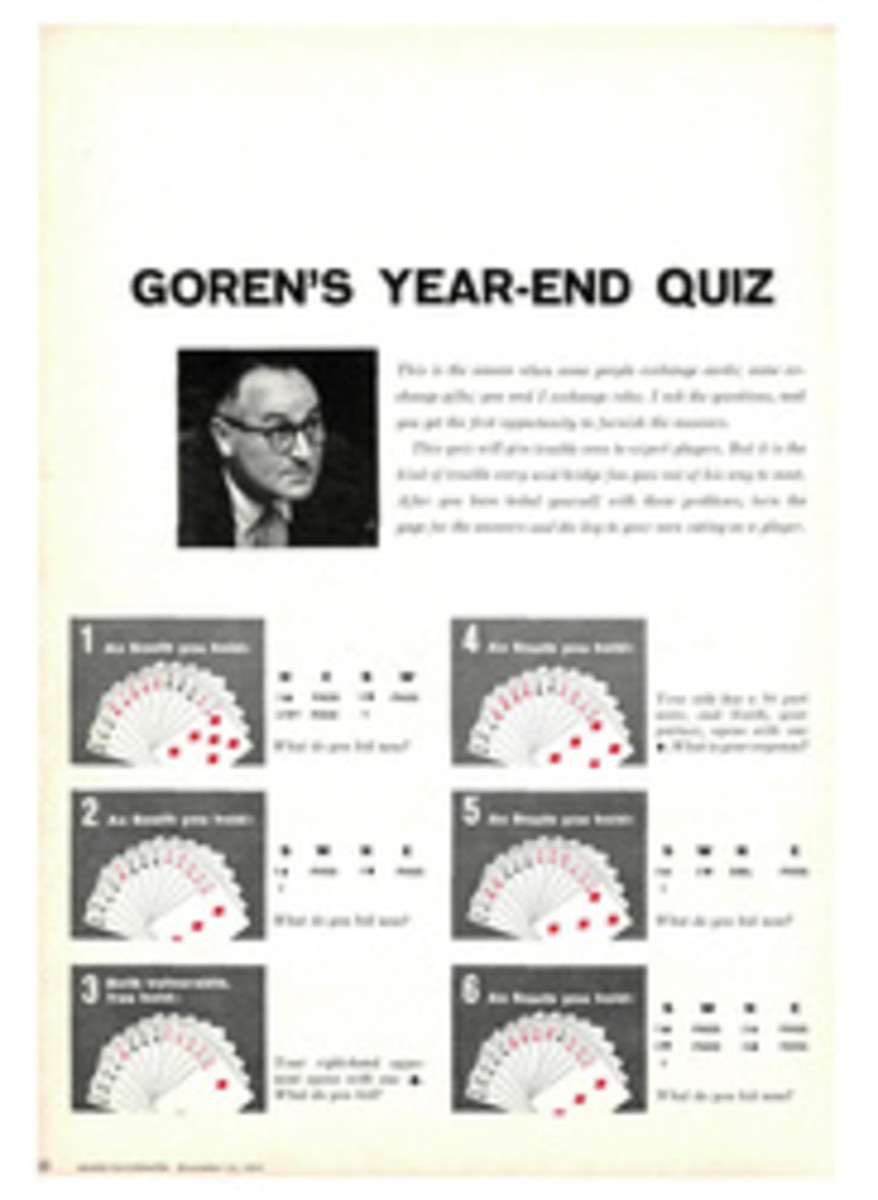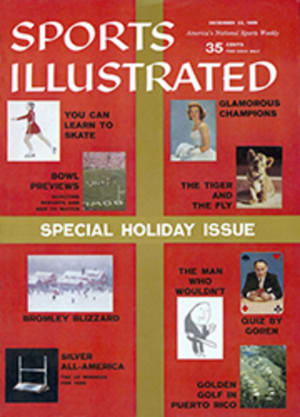
NEW COURSE IN PUERTO RICO
In the old—and it was only yesterday that they ended—the man who was lucky enough to get south for a couple of weeks in winter was confronted, if he was a golfer, with an odd kind of frustration: the warm weather was made for golf, but the facilities for the game were, with blessed few exceptions, hardly a patch on what the travel poster promised. The courses were composed of holes of insufficient length and hapless character, and the grass was hardly suited to golf since only a tough, unrefined species of weed could endure the heat. All in all, instead of being the glamorous well-to-do cousin of northern summertime golf, southern wintertime golf had a rather seedy, claptrap air about it, and many vacationers who had gone south intending to play a round a day were quickly disabused of this notion and spent the rest of their stay fishing, sailing, playing tennis or lounging on the beach, intermittently wondering why they had been stupid enough to pay the overweight charge for lugging their golf clubs along on the plane.
Today, thanks to the progress agronomists have made in producing fine new strains of grass able to withstand the searing tropical sun and thanks to a new kind of entrepreneur who purchases suitable property to begin with, hires a trained golf architect and has the financial soundness and the personal standards to see the project through on a high level, some really wonderful courses have been created in Florida and in the Caribbean area. The latest of these is Dorado Beach on the northern coast of Puerto Rico, some 20 miles west of the capital city, San Juan. Besides being an extremely beautiful course, it has such inherent championship qualities that when it was officially opened earlier this month with a $30,000 tournament, the lowest score turned in by any of the pros during the four days of play was a 68.
Dorado Beach is a project of Laurance Rockefeller. The third son and fourth child of John D. Jr. and Abby Aldrich Rockefeller, Laurance, like the other members of that remarkable family, has the gift for long-range planning and thorough execution. A man who has known the Caribbean all his life, Laurance became convinced some six years ago that an excellent way to bolster the economy of Puerto Rico would be to build a first-class resort area, previously lacking, which would attract a far greater number of tourists to the island for extended visits. In February 1955 he purchased 1,200 acres of land along the coast at Dorado, which he had been assembling in the intervening years, and called in Robert Trent Jones, the peripatetic New York golf architect, to design the golf course which would be the heart of the new development.
Four of the holes on the dramatic course which Jones built—it is undoubtedly his finest piece of work since Peachtree in Atlanta—follow closely along the ocean. The remainder swing inland through grapefruit groves and the partially cleared tropical jungle and follow strategically alongside a chain of four lakes, the largest of which is the Mata Redonda Lagoon. In the process of construction, 4,000 coconut palms were uprooted (and transplanted) to make room for the projected fairways, and a billion yards of fill was brought in, mainly to resurrect the depressed swampy area around the lagoon. As for the grass, a most important consideration, a planeload of Gene Tift grass, a hybrid African Bermuda grass developed by Mr. Tift in southern Florida, was flown in and transplanted on the future 11th fairway to serve as a nursery. The rest of the course—tees, fairways and greens—was sprigged with cuttings of stolons taken from this nursery. The course, 7,115 yards long from the championship tees but modifiable to 5,840 yards from the ladies' tees, was ready for play last winter. It is watered via a piping system that taps an underground river discovered during construction.
Dorado Beach—along with the golf course the resort area has a central hotel and cottages, tennis courts, horse-drawn Victorias and two crescent beaches on its two miles of shore line—is the latest of Laurance Rockefeller's projects dealing with the development of land. To make it easier to keep straight the individual personalities and activities of the five Rockefeller boys, it has become customary in recent years to tag each of them with a few quick (and admittedly oversimplified) phrases of description. For example, Laurance, who is 48, is inveterately referred to as the conservation addict of the family and as the son most interested in science and the application of venture capital to bolster new companies whose products are not unrelated to the national "big picture." Early in the war, for instance, Laurance invested in McDonnell Aircraft because he thought the owner of the minuscule company was onto something of immense value to the country, and he was quite right since McDonnell went on to produce the revolutionary Banshee jet planes. Quite similarly, through his investment Reaction Motors, a small company with a good idea, went on to produce the rocket engine for the Bell XSI, the first plane to break the sound barrier. His activities are wide-ranging, to say the least. For instance, in a private Point Four program somewhat similar to his brother Nelson's IBEC operations, Laurance transported an entire textile mill from South Carolina to the Belgian Congo where it manufactures cloth from local raw materials for the local market.
Tall, lean and discerning of eye, Laurance Rockefeller at first meeting conveys a somewhat ministerial impression which leaves one quite unprepared when he reveals himself, as he does quickly, to be a different type of fellow altogether, a man of bounding drive and convivial intelligence who is au courant to the point of being positively hep. At the same time, there is, however, a classical strain in Laurance which is perhaps best illustrated by the two conservation projects he has carried out superbly. In the first of these, Jackson Hole in Wyoming, he took over from his father, who in the mid-'20s was appalled at the way the grandeur of the Old West was so rapidly falling before the "beer-bottle and hot-dog civilization" and who started to purchase parcels of land in the Grand Teton area. In 1949 Laurance completed this complicated undertaking, turning over to the Secretary of the Interior 34,000 acres of magnificent land which was officially made a part of the Grand Teton National Park. Two years ago the federal government accepted as its 29th and newest national park some 5,000 acres which comprise just about half of the island of St. John in the Virgin Islands. Laurance had first purchased a 650-acre resort area on St. John called Caneel Bay and then had become so smitten with the unspoiled tropical beauty of the region that he started to take the steps that would eventually result in a new national park which everyone could enjoy and which would remain unspoiled because the government would own it in perpetuity.
The Rockefellers not only do things well, they do them right. Last spring, for illustration, after a luncheon for the press in which the news about Dorado Beach was released—Laurance talking about the over-all project and introducing his aides, who went into the aspects they had worked on—a veteran newspaperman approached one of the aides in a corner of the room and asked him if the course was intended only for visitors from the States. The aide answered no, that it was open to the Puerto Ricans as well. "Yes, I know," the newspaperman continued, "but have any Puerto Ricans actually played on it?" The aide, somewhat baffled by the conversation, answered that 250 Puerto Ricans were members of the club and actually ran it—that, technically, Laurance Rockefeller himself had to go through the formality of being elected a member by the resident group. At this point the newspaperman shook his head drolly and said in an altogether different tone, "You see, the reason why I asked you these things is that nine times out of 10 when anyone does anything that's as commendable as this, they not only make a point of telling you about it, they make a real production of it. You people didn't even mention it."
PHOTO
MAN BEHIND Dorado Beach is Laurance S. Rockefeller (left) who built Puerto Rican golf resort, shown in aerial view at right
PHOTO
EZRA STOLLER
[See caption above.]
PHOTO
EZRA STOLLER
JUNGLE VEGETATION, an impressive feature of the Dorado Beach golf course, provides a lush frame for the 16th tee, where a threesome, closed in by white-barked royal palms, strikes out onto the fairway
TWO PHOTOS
EZRA STOLLER
CHICKEN TREE, so called by the people of Puerto Rico because of its spread-toe base, is shown above in closeup and below as it forms the bright border for the short 13th. Back tee is beyond pond at right.
PHOTO
Mrs. Colby Chester, Mrs. Thomas Choate chat at recent Dorado golf pro-am event.
PHOTO
Pro Chick Harbert (right) and Van Horn Ely Jr. head for the first tee at Dorado.

